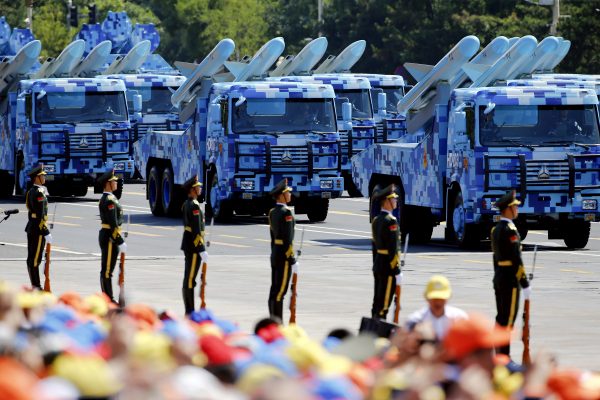On 1 February 2019, US President Trump said that he would suspend obligations under the INF Treaty and initiate the withdrawal procedure. After withdrawing, the United States might deploy conventional and nuclear missiles to the West Pacific against China. How would the potential deployment of each missile type impact China’s security?
The question of whether China should join the INF Treaty is frequently mentioned in US policy debates. The answer is a clear no. First, China is bounded by four nuclear-armed states. Nuclear land-based ballistic missiles are the backbone of China’s nuclear deterrence. In contrast, the United States does not need INF to deter its neighbours, while Russia has reliable air- and sea-based INF capabilities (which are not prohibited by the Treaty).
Second, China lacks the means for long-range force delivery. From a military perspective, a conventional ballistic missile is not cost-efficient, but China has limited options given its poor naval and air capabilities.
All the same, the deployment of US nuclear missiles to the West Pacific would have little impact on China’s nuclear deterrence. Currently, the United States has 3800 active nuclear warheads, while China’s total number of nuclear warheads is estimated to be 280. Given the asymmetry, the impact on strategic stability of deploying additional land-based INF would be marginal.
China’s nuclear deterrence is based on hiding, concealing and manoeuvring nuclear missiles, making them difficult to locate. Improvement in US intelligence, surveillance, reconnaissance and missile defence would undermine China’s nuclear deterrence, but additional land-based INF could not. Politically, the United States re-deploying nuclear missiles in the territory of its East Asian allies would probably be seen by China as a sign of aggressive nuclear posturing and cause strong opposition.
US conventional land-based missiles deployed in the West Pacific would have limited impact on the Sino-US conventional military balance. It was reported that the United States will develop two types of land-based missiles after the withdrawal: the land-based Tomahawk cruise missile (with a range of 1000 kilometres) and a new type of ballistic missile (range of 2800–3800 kilometres). Earlier reports suggested that the US Army is seeking to develop a Precision Strike Missile with a 499 kilometre range. After the INF Treaty’s demise, the range of the missile will probably be extended.
Land-based cruise missiles are not a new threat to China. The United States already has the capabilities to launch cruise missiles from aircraft, surface ships and submarines. Compared with other platforms, the trajectory, reaction time and lethality of land-based cruise missiles are no different. The difference is that the US military will have more and cheaper options. From China’s perspective, land-based cruise missile launchers are relatively easier to locate and attack than submarines, surface ships and bombers (though doing so is still difficult).
The withdrawal will also have no impact on the hypersonic boost-glide missiles being developed by the US Army, because the boost-glide missiles — with a different trajectory from ballistic and cruise missiles — are believed not to be subject to the INF Treaty.
In contrast to nuclear and conventional cruise missiles though, conventional medium-range ballistic missile (MRBMs)/intermediate-range ballistic missiles (IRBMs) represent a new threat to China. Previously, the US Army’s conventional short-range ballistic missiles posed no threat to China, while the US Air Force’s intercontinental ballistic missile and the Navy’s submarine-launched ballistic missiles both carried only nuclear warheads. Compared with cruise missiles, ballistic missiles have higher speeds and shorter flight times. It would take a subsonic cruise missile one hour to fly a range of 1000 kilometres, while a ballistic missile only needs eight minutes.
This feature makes ballistic missiles more suitable for attacking so-called time-sensitive targets, such as mobile missile launchers (after the launch of a missile, the position of the launcher is exposed and must move before the enemy’s strike weapons arrive). Conventional MRBMs/IRBMs would improve the US military’s capability to attack Chinese missile launchers. In this sense, the deployment of conventional MRBMs/IRBMs is equivalent to the deployment of hypersonic missiles ahead of time.
In sum, the US withdrawal from the INF Treaty and subsequent deployment of nuclear missiles in the West Pacific will impose zero impact on China’s nuclear deterrence, though the latter would probably cause serious political opposition. The deployment of conventional missiles by the United States on the other hand has a limited impact on China’s security, mainly reflected in the increased ability of the US military to attack time-sensitive targets.
Dr Wu Riqiang is a Research Fellow at the Belfer Center for Science and International Affairs, Harvard Kennedy School. He is also an Associate Professor at the School of International Studies, Renmin University of China, Beijing.


Might it be reasonable for the US, Russia, China to agree to reduce the number of nuclear weapons to the levels that China currently holds, and also agree to commit “no first strikes as a strategic posture? Would that not make the world as a whole safer?
It is unlikely that either Russia or the the US, particularly the latter to agree with that, because in that way the two, particularly the US, would lose a big advantage they have at the moment over China. Why would they do that, particularly as the US has now regards China and Russia as almost like its enemies?